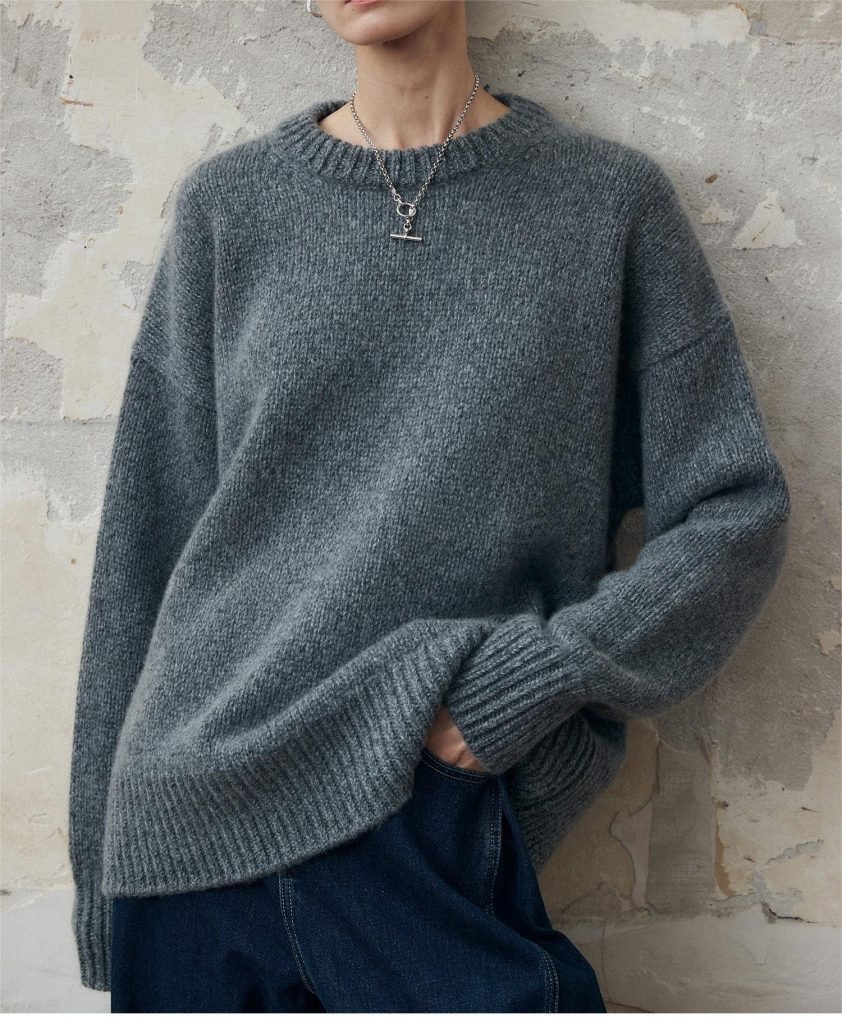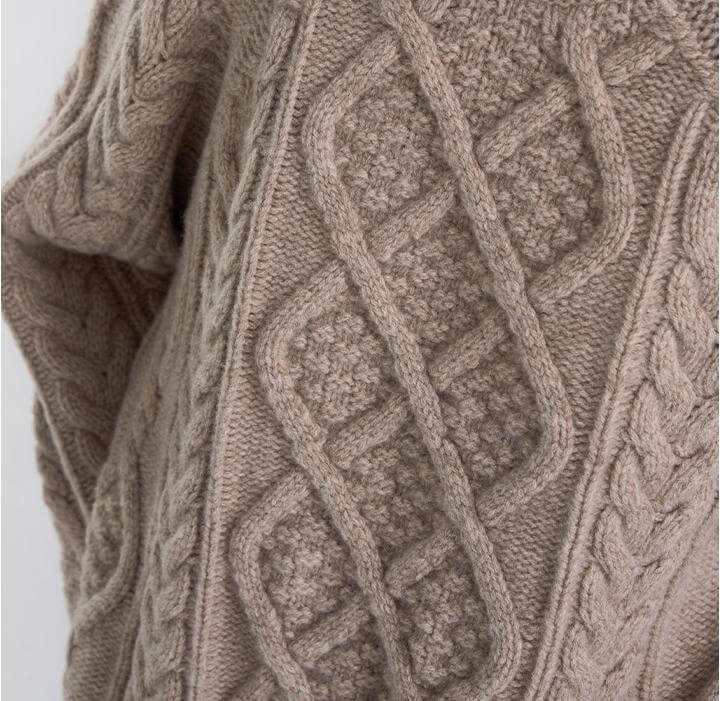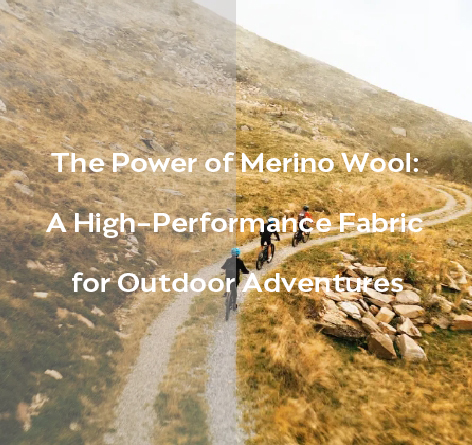Wool has been a cornerstone of fashion design for centuries, valued for its versatility, durability, and natural comfort. As one of the oldest materials used in garment creation, wool continues to inspire modern textile designers with its wide range of textures and finishes. Understanding the types of wool in fashion, especially woolen and worsted wool, is essential for creating high-quality knitwear using fully-fashioned knitting technology. If you want to learn more about fully-fashioned knitwear, refer to this [comprehensive comparison](https://guooufashion.com/fully-fashioned-vs-cut-and-sew-knitwear-a-comprehensive-comparison).
Choosing the right wool type can greatly enhance the quality and appeal of your knit designs. Woolen wool is prized for its soft, fluffy texture and excellent insulation, making it perfect for comfortable sweaters and casual wear. In contrast, worsted wool offers a smoother, refined finish suitable for sleek, structured knit pieces. By thoroughly understanding the differences between these two wool types, fashion designers can make informed choices that improve their creations’ aesthetic and functional qualities.
What is Woolen Wool and Worsted Wool?
Understanding the fundamental differences between woolen and worsted wool is essential for any fashion designer aiming to create high-quality garments. These two types of wool vary significantly in their texture, production processes, and suitable applications, influencing the overall look and functionality of the final product.
1. Woolen Wool

Woolen wool is characterized by its soft, fluffy texture and excellent warmth, making it a popular choice for cozy and comfortable garments. The bulkiness of woolen wool stems from its unique spinning process, which involves carding the wool fibers.
- Spinning Process: Woolen wool is produced using the carding method, where short fibers are tangled together, creating more air pockets within the yarn. This process results in a thicker, loftier fabric that provides superior insulation.
- Uses: Due to its warm and bulky nature, woolen wool is ideal for creating garments such as sweaters, scarves, and outerwear. These pieces benefit from the fiber’s ability to trap heat, offering both comfort and style during colder seasons.
2. Worsted Wool
In contrast, worsted wool is known for its smooth, firm texture and enhanced durability. The production of worsted wool involves a more refined spinning process that aligns the wool fibers more closely, resulting in a sleek and structured fabric.
- Spinning Process: Worsted wool is created through the combing process, which removes shorter fibers and aligns the longer ones. This meticulous method produces a denser and more uniform yarn, contributing to the fabric’s strength and smooth finish.
- Uses: The refined texture of worsted wool makes it suitable for tailored garments such as trousers, blazers, and other structured knit pieces. Its durability ensures that these garments maintain their shape and appearance over time, making worsted wool a preferred choice for professional and high-quality fashion items.
The Key Differences Between Woolen and Worsted Wool
When selecting the appropriate wool for fashion design, understanding the differences between woolen and worsted wool is essential. These two types of wool vary significantly in texture, spinning process, appearance, structure, and durability, each catering to distinct design needs and garment functionalities.
1. Texture

Woolen wool is renowned for its soft, fluffy, and bulky texture. This plush feel makes it ideal for creating cozy and comfortable garments such as sweaters, scarves, and casual outerwear. The inherent bulkiness of woolen wool not only adds to the garment’s warmth but also provides a relaxed and inviting aesthetic.

In contrast, worsted wool offers a smooth, sleek, and firm texture. This refined surface is perfect for garments that require a polished and professional appearance, such as base layers and structured knit pieces. The sleekness of worsted wool lends a sophisticated look, making it suitable for designs that prioritize structure and elegance.
2. Spinning Process

The spinning process is a critical factor that distinguishes woolen wool from worsted wool. Woolen wool undergoes a carding process, where short fibers are tangled and intertwined to form a loose and thick yarn. This method emphasizes volume and warmth, making woolen wool perfect for garments that require a high level of insulation.
On the other hand, worsted wool is produced using a combing process, which aligns longer fibers and removes shorter ones to create a smooth and dense yarn. This meticulous technique results in a fabric that is not only smoother and more durable but also maintains its shape better over time. The combing process enhances worsted wool’s strength and sleek texture, making it ideal for base layers that require both comfort and durability.
3. Appearance and Structure
Woolen wool offers a bulky, textured, and more rustic appearance. This fullness and softness give garments a relaxed and comfortable look, ideal for casual and everyday wear. The textured surface of woolen wool adds depth and character to the fabric, making it visually appealing for designs that prioritize comfort and warmth.
Conversely, worsted wool presents a sleek, smooth, and refined appearance, often featuring a glossy finish. This polished look is perfect for creating structured and elegant garments that exude professionalism and sophistication. The uniformity and density of worsted wool enhance the garment’s shape and drape, making it an excellent choice for pieces that require a sharp and tailored silhouette, including base layers that form the foundation of layered outfits.
4. Durability
When it comes to durability, worsted wool stands out as the more resilient and long-lasting option. Its tight fiber structure and longer fibers make it resistant to pilling and wear, ensuring that garments maintain their shape and quality over time. This durability makes worsted wool ideal for high-end fashion items and base layers that are intended to withstand regular use while retaining their pristine appearance.
In contrast, woolen wool is softer but less durable in the long run. The looser fiber arrangement in woolen wool can lead to quicker wear and tear, especially in high-contact areas of garments. While woolen wool provides exceptional comfort and warmth, its softer fibers are better suited for garments that prioritize coziness over longevity, such as casual sweaters and scarves.
Woolen vs Worsted: Which Is Best for Fashion Design?
Choosing between woolen and worsted wool depends largely on the specific requirements of the garment and its intended use. Woolen wool excels in creating cozy and casual clothing, while worsted wool is ideal for base layers and delicate knitwear. Understanding these distinctions enables designers to select the most suitable wool type to achieve their desired aesthetic and functionality.
1. Woolen Wool
Woolen wool is the preferred choice for crafting casual and comfortable garments. Its inherent warmth, bulk, softness, and excellent insulation make it perfect for pieces that prioritize comfort and coziness. Designers often use woolen wool to create sweaters, shawls, and outerwear, which benefit from the fabric’s ability to retain heat and provide a relaxed fit. The bulky texture of woolen wool allows for looser silhouettes, enhancing the garment’s comfort without compromising on style.
The advantages of woolen wool extend to its versatility in cold weather wear and casual looks. Its soft and fluffy texture not only feels pleasant against the skin but also adds a touch of luxury to everyday attire. However, it’s important to note that woolen wool may cause itching for individuals with sensitive skin due to its looser fiber arrangement.
2. Worsted Wool
In contrast, worsted wool is ideal for base layers and delicate knitwear, offering durability, a crisp finish, and a sleek appearance. This type of wool is commonly used to design base layers, lightweight sweaters, and fine-knit accessories, where a polished and refined look is essential. The smooth and firm texture of worsted wool allows for sharper lines and more structured silhouettes, making it perfect for garments that require a subtle yet sophisticated appearance.
Worsted wool’s durability ensures that garments maintain their shape and resist wear over time, making it a preferred choice for pieces that require longevity and a pristine appearance. Additionally, worsted wool is a better option for those with sensitive skin, as its smoother fibers are less likely to cause irritation or itching. Its sleek finish also enhances the garment’s overall sophistication, making it suitable for settings that demand a refined look.
3. Choosing Based on Design Type
The decision between woolen and worsted wool largely depends on the design type and the desired fit of the garment. Woolen wool’s bulkiness works exceptionally well for looser fits, providing a relaxed and comfortable silhouette that is perfect for casual and cozy pieces. On the other hand, worsted wool’s structure supports tailored looks, ensuring that garments retain their shape and offer a sleek, professional appearance.
Many renowned designers and brands utilize both types of wool to cater to different segments of their collections. For instance, brands focusing on winter casual wear may prefer woolen wool for its warmth and softness, while those designing high-quality knitwear opt for worsted wool to achieve a refined and enduring finish. Understanding these applications allows designers to effectively incorporate the right wool type into their collections, enhancing both the functionality and aesthetic appeal of their garments.
Cost Comparison: Woolen vs Worsted Wool
When budgeting for fully-fashioned knitwear projects, understanding the cost differences between woolen and worsted wool is crucial. Generally speaking, woollen wool is more affordable, often costing only 50% to 80% of the price of worsted wool, depending on the quality. This price variation primarily reflects their distinct production processes and material qualities.
Woolen wool benefits from a simpler carding process and a bulkier texture, which require fewer resources and less labor. The carding method tangles shorter fibers, creating a thicker and airier yarn that is cost-effective for producing cozy and casual knitwear like sweaters and scarves. Additionally, the use of shorter fibers in woolen wool contributes to its lower price point, making it an economical choice for large-scale projects.
In contrast, worsted wool commands a higher price due to its meticulous combing process and superior finish. The combing method aligns longer fibers and removes shorter ones, resulting in a smoother and more durable yarn. This labor-intensive technique not only enhances the fabric’s durability and sleek appearance but also increases production costs. As a result, worsted wool is ideal for delicate knitwear and base layers that require both comfort and longevity, justifying its higher cost.
When budgeting for wool, designers should consider both the project budget and the desired garment quality. Woolen wool offers an affordable solution for creating warm and comfortable pieces without straining the budget, while worsted wool is a worthwhile investment for high-quality, long-lasting knitwear that demands a refined finish.
How to Choose Between Woolen and Worsted Wool for Your Design Projects
Selecting the appropriate wool type is pivotal for achieving the desired aesthetic and functionality in your fully-fashioned knitwear projects. Woolen and worsted wool each offer distinct advantages tailored to different design requirements. This section provides clear guidelines to help designers make informed choices based on key factors.
1. Garment Type
The type of garment you aim to create significantly influences your wool selection:
- Woolen Wool: Best suited for casual and soft garmentssuch as chunky sweaters, cozy shawls, and comfortable outerwear. Its plush texture enhances warmth and comfort, making it ideal for everyday wear.
- Worsted Wool: Perfect for formal and professional pieces, including lightweight sweaters, fine-knit base layers, and elegant accessories. Its sleek and smooth finish imparts a polished and sophisticated appearance.
2. Texture and Finish

The texture and finish of the wool directly impact the garment’s feel and appearance:
- Woolen Wool: Offers a soft, fluffy texturethat provides excellent insulation and a cozy feel, making it ideal for garments that prioritize warmth and comfort.
- Worsted Wool: Features a smooth and sleek finish, delivering a sophisticated and polished appearance. This refined texture is perfect for creating garments that require a structured and elegant look.
3. Budget Considerations
Budget plays a crucial role in wool selection, especially for large-scale projects:
- Woolen Wool: Generally more affordable, making it a cost-effective option for bulk productionof casual and warm knitwear. Its simpler production process allows for higher quantities without significantly increasing costs.
- Worsted Wool: More expensivedue to its labor-intensive combing process and superior finish. This higher cost is justified for luxury and professional garments that demand durability and a pristine appearance.
4. Design Needs

Aligning wool type with specific design needs ensures optimal garment performance:
- Woolen Wool: Ideal for designs that require looser fitsand relaxed silhouettes, enhancing comfort and ease of movement. Perfect for creating versatile pieces that cater to a wide audience.
- Worsted Wool: Suited for tailored and structured designs, ensuring garments maintain their shape and offer a sleek, professional appearance. Excellent for creating high-quality, long-lasting knitwear that stands out in formal settings.
5. Practical Application
When designing fully-fashioned knitwear, consider how each wool type aligns with your specific series:
5.1 Leisure Series

Woolen Wool: Perfect for the Leisure Series, which includes casual and comfortable knitwear such as oversized sweaters, relaxed hoodies, and soft scarves. The bulkiness and warmth of woolen wool enhance the comfort and coziness of these pieces, making them ideal for everyday wear and relaxed environments.
Worsted Wool: While primarily used for more formal garments, worsted wool can add a touch of sophistication to leisure pieces, such as refined cardigans or lightweight knit accessories, offering a balance between comfort and style.
5.2 Business Commuting Series
Worsted Wool: The Business Commuting Series benefits greatly from worsted wool’s sleek and professional finish. Lightweight sweaters, fine-knit cardigans, and elegant scarves made from worsted wool provide a polished look suitable for office environments and professional settings.
Woolen Wool: Can be used sparingly in the Business Commuting Series for adding layers that offer warmth without compromising on style, such as cozy shawls or comfortable yet stylish outerwear.
5.3 Sports Series
Worsted Wool: Ideal for the Sports Series, which includes active and performance-oriented knitwear like base layers, moisture-wicking sweaters, and flexible accessories. The durability and sleek texture of worsted wool ensure these garments retain their shape and functionality during physical activities.
Woolen Wool: While less common in high-performance sportswear, woolen wool can be used for non-active pieces within the Sports Series, such as casual joggers or comfortable hoodies, where warmth and softness are prioritized over performance.
Common Mistakes When Using Woolen vs Worsted Wool in Fashion Design
Choosing the right type of wool is crucial for creating high-quality fully-fashioned knitwear. However, even experienced designers can make mistakes that compromise both the comfort and durability of their garments. Understanding these common pitfalls can save time and money, ensuring that the correct wool type is chosen for each project. This section highlights the most frequent errors and provides practical solutions to avoid them.
1. Ignoring Texture Differences
One of the most common mistakes is not matching the wool texture to the desired garment. Each type of wool offers unique characteristics that suit different clothing needs.
- Mistake: Using woolen woolfor garments intended to be worn close to the skin, such as t-shirts or intimate wear. The messier, bulkier structure of woolen wool, resulting from the carding process, can cause discomfort or itchiness, especially for individuals with sensitive skin.
- Solution: Opt for worsted woolwhen designing close-to-body garments. Its smoother texture and finer fibers provide greater comfort and reduce the likelihood of irritation, making it a better choice for items like base layers and delicate knitwear.
2. Misjudging Durability
Another frequent error is using woolen wool for garments that require long-term wear. While woolen wool is exceptionally soft, it lacks the durability needed for high-contact areas.
- Mistake: Incorporating woolen woolinto designs that undergo regular wear and tear, such as elbows and knees in sweaters or trousers. Over time, woolen wool can wear out faster than worsted wool, leading to pilling and loss of shape.
- Solution: Choose worsted woolfor garments intended to last longer or withstand heavy use. Its tighter fiber structure and longer fibers enhance durability, making it ideal for business attire, trousers, and other pieces that require resilience and longevity.
3. Inappropriate Fabric Weight
Selecting the wrong fabric weight can significantly impact the appearance and functionality of a garment. Woolen wool and worsted wool differ not only in texture but also in their suitability for various fabric weights.
- Mistake: Using woolen wool, which is inherently bulkier, for garments that need to drape well, such as tailored suits. This can result in an overly heavy or stiff look, detracting from the garment’s intended elegance and fluidity.
- Solution: Utilize worsted woolfor designs requiring a refined drape and structure. Its smoother and denser yarn allows for a sleek and polished finish, perfect for blazers, high-quality trousers, and other tailored pieces that demand a sophisticated silhouette.
Conclusion
Selecting the right type of wool is essential for creating high-quality fully-fashioned knitwear that meets both aesthetic and functional standards. By considering factors such as garment type, texture and finish, budget, and design needs, designers can make informed decisions that enhance the comfort, durability, and style of their creations. Whether opting for the cozy warmth of woolen wool for casual pieces or the sleek sophistication of worsted wool for professional attire, understanding these key elements ensures that each garment fulfills its intended purpose effectively.
Encouraging experimentation with both woolen and worsted wool can lead to a more versatile and innovative design portfolio. Combining the plush comfort of woolen wool with the refined structure of worsted wool allows designers to explore new creative possibilities and cater to diverse market demands.
If you are a brand or wholesaler unsure about selecting the right wool for your projects, HD is here to help. Send us your design, and we will provide you with free wool selection suggestions tailored to your specific needs. Visit our Blog & News section for more insights, or reach out to our team directly to start perfecting your wool choices today.







